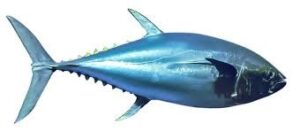
BLUE FIN TUNA
Bluefin are the largest tunas and can live up to 40 years.
They migrate across all oceans and can dive deeper than 3,000 feet.
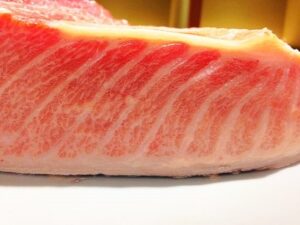
Three Different Parts of the Tuna
Toro (toh-roh) is the term for the fatty part of the tuna, found in the belly portion of the fish.
Chutoro (choo-toh-roh), which is sometimes labeled chu-toro, is the belly area of the tuna
along the side of the fish between the akami and the otoro.
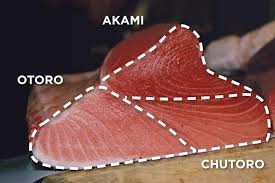
Akami (ah-kah-me) is the leaner meat from the sides of the fish.
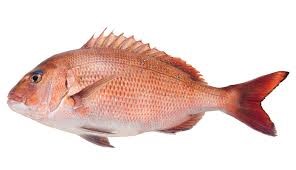 MADAI (Sea Bream)
MADAI (Sea Bream)
Sea Bream is known as Madai in Japan. It is prized for its flavor and for being
the “celebration” fish, served at special occasions dating back thousands of years.
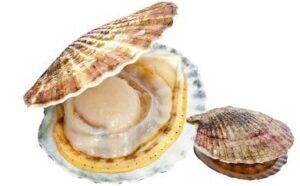
HOTATE (Japanese Scallop)
Hotate (scallops) – Scallops are a common favorite sushi topping.
They have an extremely smooth, glossy flesh with a gentle and slightly sweet flavor.
To prepare scallops for nigiri, the round flesh is sliced across the center to butterfly it.
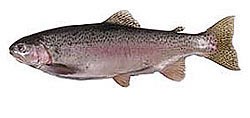
OCEAN TROUT
Also referred to as Steelhead Trout or Sea Trout, we most commonly familiar with
these fish in the U.S. as the ocean-going “steelhead” trout (or even as the “salmon trout”).
With a relatively small head and a black-spotted silver hide, it has the characteristic pink lateral stripes common to rainbow trout.
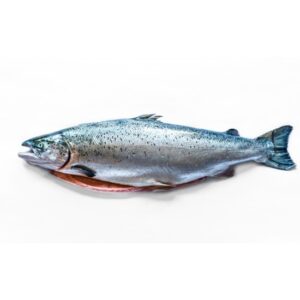
ORGANIC SALMON
Organic Salmon is a kind of organic food Salmon that grows in its natural state. And organic salmon production must be carried out in uncontaminated water. Because of its limited growth conditions, organic salmon have high standards for water quality, environment, and nutrients, and do not eat artificial feed.
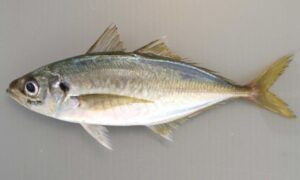 AJI (Horse Mackerel)
AJI (Horse Mackerel)
Aji is very popular in Japan (primarily when served as sushi) and is especially healthy,
packed with omega-3s, DHA and EPA. It is usually garnished with wasabi, ginger, and
scallions to bring out the flavors of the fish. Most of the skin is removed during preparation,
leaving a pinkish, appealing flesh. Aji’s taste is delicate and sweet yet flavorful.
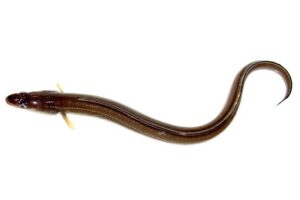 ANAGO (Sea eel)
ANAGO (Sea eel)
Anago is the Japanese word for salt-water eels. They are often simmered or deep-fried,
compared to unagi which are usually barbecued with a sauce. Anago is also slightly less rich and oily than unagi.
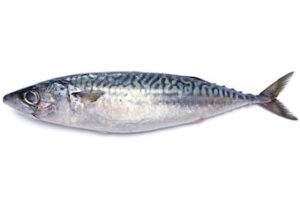 SABA (Mackerel)
SABA (Mackerel)
Saba is the Japanese word for the chub, or Pacific mackerel, which is just one of many species of fish classified as mackerel.
The fish is very commonly consumed throughout Japan, and is popular because of its nutritional value.
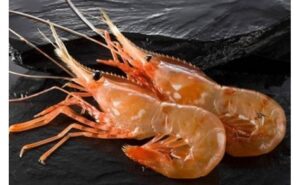 BOTAN EBI (Botan Shrimp)
BOTAN EBI (Botan Shrimp)
Botan Ebi (ボタンエビ “Pandalus nipponensis”) are pandalid shrimp, orange-red in color
and approximately 20cm long. They are a Hokkaido speciality, and their fishing season is from October to May.
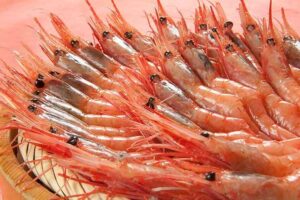
AMAEBI (Sweet Shrimp)
Amaebi are cold water northern shrimp known and named for their sweet taste. They are the only species of shrimp which are best enjoyed raw, as cooking them will rob them of their full sweetness. They are served on nigiri-Sushi, or fingers of sushi rice, and often accompanied by their fried shells and heads.
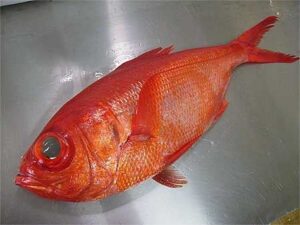 KINMEDAI (Splendid Alfonsino)
KINMEDAI (Splendid Alfonsino)
Kinmedai or Golden Eye Snapper in Sushi, has a peculiar appearance; it is a bright red fish with very large eyes due to its preference for deep waters.
Kinmedai’s flesh is delicate and tender, with good fat content for a shiromi and the taste is mild yet full of umami flavors.
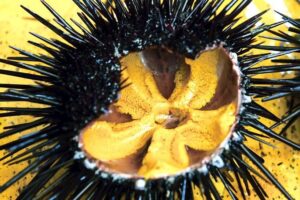 UNI (Sea Urchin)
UNI (Sea Urchin)
Uni is often called sea urchin roe (that is, eggs, like caviar), the creamy orange lobes of briny-umami delight that is Uni are actually the urchin’s version of ovaries or testicles.
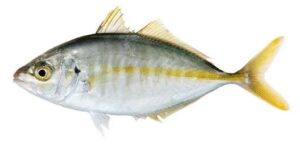 SHIMA AJI (Japanese Stripe Jack)
SHIMA AJI (Japanese Stripe Jack)
Shima Aji – Part of the Aji/Horse Mackerel family that’s in peak season during the summer, but available year round. Usually recognized for its bright yellow stripe across the body, this fish can grow up to one meter in length. This fish is rich and smooth in flavor.
 HAMACHI (Yellowtail)
HAMACHI (Yellowtail)
Hamachi can be as rich as toro, smooth and buttery with a deep smoky taste, but not as overpoweringly fatty..
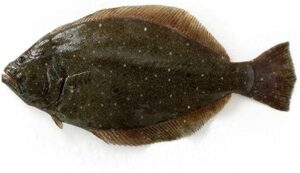 HIRAME (Fluke)
HIRAME (Fluke)
Hirame is a flatfish that is usually found in the Pacific and Atlantic Oceans.
Unlike other types of sashimi, hirame has ‘hagotai’ (which means ‘bite’).
The texture is slightly crunchy and chewy, which brings out the sweetness of the fish with every bite.
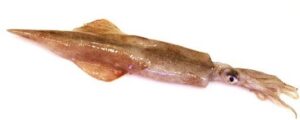 YARI IKA (Spear Squid)
YARI IKA (Spear Squid)
Yari Ika is a type of cuttlefish but is also known as a Spear squid.
It is usually cut for use in nigiri type sushi but it can also be eaten as sashimi. Their flesh is comparatively thin, but soft and sweet. They are among the most popular in Japan.
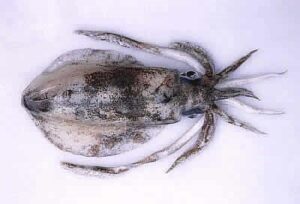 AORI IKA (Bigfin Reef Squid)
AORI IKA (Bigfin Reef Squid)
Aori Ika is another extremely popular cuttle fish not only in Japan, but in many other countries.
They are considered the best cuttlefish as far as sashimi is concerned.
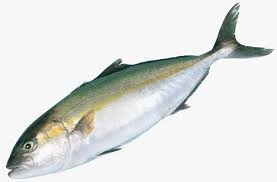 KANPACHI (Japanese Amber Jack)
KANPACHI (Japanese Amber Jack)
Kanpachi is from the same genus as the Yellowtail, but the two species are slightly different.
This fish is native to the waters of the Pacific Northwest.
Kanpachi can grow up to six feet long but are usually caught at a smaller size and are best
enjoyed during the autumn and winter months.
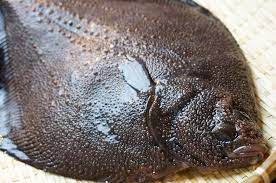
SAME KAREI (Shark Skin Flounder)
Same karei is a deep water fish found in the seas off Hokkaido. It has a rough skin like sharks skin hence the name “same karei” . Caught wild it’s a fish to enjoy during summer time .
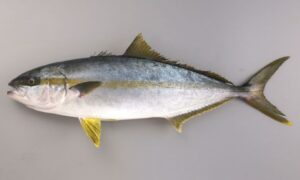 HIRAMASA (Yellowtail Amberjack)
HIRAMASA (Yellowtail Amberjack)
Hiramasa (Yellowtail Amberjack) has white, firm flesh and is renowned for its high level of Omega 3 and other beneficial fatty acids. Hiramasa is the Japanese name for this fish and it is highly regarded in Japan. Hiramasa Kingfish (Seriloa lalandi) is the Australian name for this fish, and it is also a high quality sashimi grade fish. Hiramasa has pale pink flesh with firm, large flakes and a sweet, rich flavor. Hiramasa has a higher fat content, firmer texture and cleaner flavor than wild Yellowtail.
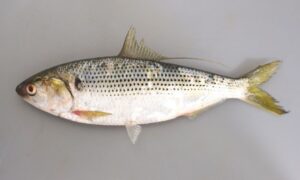 KOHADA (Gizzard Shad)
KOHADA (Gizzard Shad)
Kohada is particularly popular pickled in salt and vinegar before being served either as sashimi or sushi.
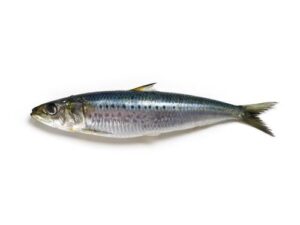 IWASHI (Sardine)
IWASHI (Sardine)
Freshest fatty Iwashi in season has creamy taste and they are at double the fat.
While the flesh is tender and has simple taste, the fat has rich umami flavor.
As sushi toppings, they are eaten raw or marinated in vinegar to gain refreshing taste.
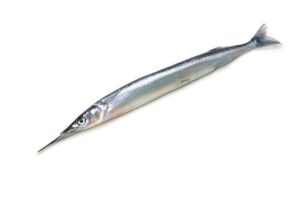 SAYORI (Half Beak)
SAYORI (Half Beak)
It is a beautiful, long, and slender fish with an elongated lower jaw and delicate,
almost transparent flesh. It begins to appear on menus in the late fall, and peaks in
quality in the early spring.3
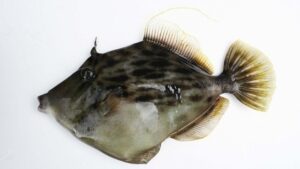 KAWAHAGI (File Fish)
KAWAHAGI (File Fish)
Kawahagi is a flat, sand-dwelling fish found in Japan’s coastal areas. It reaches a length of 8 to 10 inches.
When served as nigiri-sushi, it is usually served with its own liver. It is a delicious and often very
expensive seasonal item that appears in high-end sushi restaurants from late October until the beginning of December, then disappears from the menu for another year.
The taste of the fish itself is quite subtle and delicate, not unlike Hirame, but the addition of the liver adds a decadently creamy element to the nigiri, making it an intoxicatingly rich delicacy.
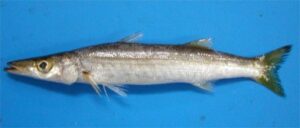 KAMASU (Barracuda)
KAMASU (Barracuda)
it is usually served with some of its skin still on, lightly seared “aburi” style, and with some minced ginger accompaniment. A tasty, mild-flavored fish that is deservingly popular.
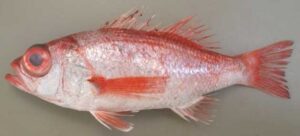 AKA-MUTSU (Blackthroat Seaperch)
AKA-MUTSU (Blackthroat Seaperch)
A deep sea dweller, it offers a very high fat content. When at their peak, Akamutsu are usually about two pounds in weight, and measure around 12 to 15 inches.
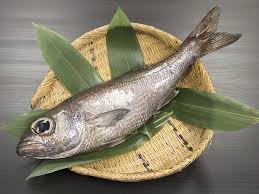
KUROMUTSU (Japanese Blue Fish)
Kuromutsu or Japanese blue fish is usually found throughout Japan’s coastline in the deep sea all year round. Seasonally, they are abundant in winter but you can find them in the Tsukiji fish market until early spring. It is one of the most delicious oily fish available locally with a distinct marbled white meat that is popularly eaten by the Japanese as sashimi.
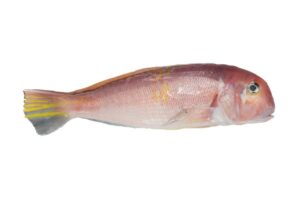 AMADAI (Tile Fish)
AMADAI (Tile Fish)
This fish is a type of Tai, so it’s part of the Sea Bream family and has a watery flesh.
It’s best consumed between October and March and usually, the red and white varieties are more popular.
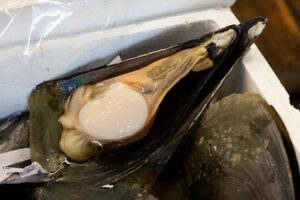 TAIRA GAI (Japanese Pen Shell)
TAIRA GAI (Japanese Pen Shell)
The tairagai’s shell can be over a foot long and it is typically believed that the longer the shell,
the better the taste. Like hotategai, only the adductor muscle is consumed. It is comparable in taste and texture to hotate, but the flesh is firmer, less sweet, and has more concentrated umami.
Most sushi lovers prefer it over hotate due to its wonderful texture.
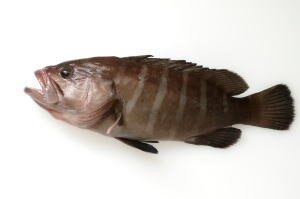 HATA (Grouper)
HATA (Grouper)
Hata is the most commonly found fish in the sea bass family. They can be found in temperate, shallow waters. With large mouths and stout bodies, these fish eat other fish and crustaceans by hanging out near reefs and sucking them in. They are fished with a single rod and are best during the winter season.
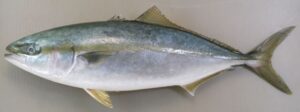 BURI (Wild Yellowtail)
BURI (Wild Yellowtail)
Buri is a name reserved for fish over 80 centimeters, while hamachi is used in the west for smaller,
cultivated Buri. In English, it is called yellowtail or, sometimes, Japanese amberjack. Wild kanburi (winter yellowtail) is considered particularly delicious.
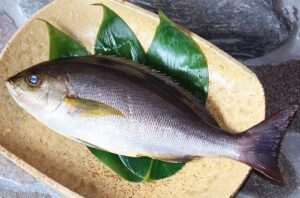 ISAKI (Chicken Grunt)
ISAKI (Chicken Grunt)
Isaki is another nice summertime shiromi. The flavor is typical of shiromi: delicate, lean and sweet.
Aging the fish for a day or two before serving further improves these attributes.
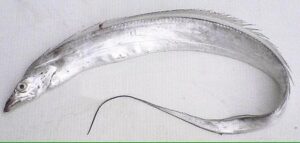 TACHIUO (Belt Fish)
TACHIUO (Belt Fish)
Tachiuo are long and slender; they can reach up to seven feet in length but most specimens are
about three feet. They’re found throughout Japan’s waters and are available year-round, although they are considered a summer treat.
Tachiuo is not a classic Edomae sushidane but some chefs still serve it as nigiri. It can be served raw or aburi. The flesh offers a pleasant texture and mild taste.
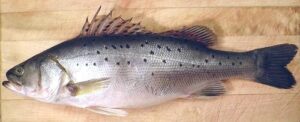 SUZUKI (Japanese Seabass)
SUZUKI (Japanese Seabass)
Suzuki is a beautiful and delicious summertime shiromi fish. Suzuki’s flesh can be either firm or soft, depending on the cut. If cut from the belly, the meat is quite high in fat content and has a very soft mouthfeel. Cuts of meat from other parts of the fish are somewhat firm and a little chewy but still retain a wonderful, sweet flavor.
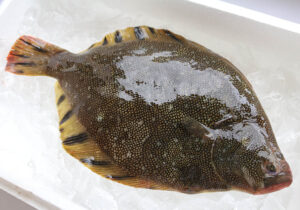
MATSUKAWA KAREI (Barfin flounder)
The origin of the name Matsukawa (pine bark) is said to be because the scales are hard and resemble the epidermis of a pine tree. Matsukawa flounder is treated as an extremely high-quality fish in the market, and is not sold in general supermarkets, but is mostly sold at high-end restaurants such as sushi restaurants and Japanese cuisine restaurants.
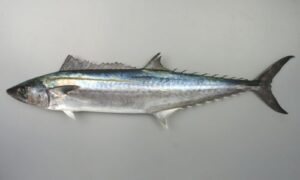
SAWARA (Japanese Spanish mackerel)
Sawara is a type of mackerel and it has a beautiful white flesh but without the reddish parts like a typical mackerel. It has a texture that melts in the mouth and a unique flavor where the skin meets the flesh. This is the secret to sawara’s popularity.
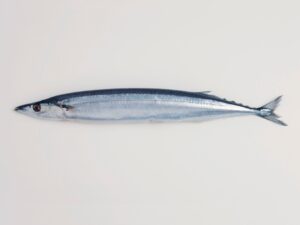
SANMA (Pacific Saury)
Sanma or Pacific Saury is not a traditional Edomae fish served as sushi. More famous for being grilled with salt, Sanma comes into season during the autumn, with its name 秋刀魚 meaning autumn knife, with its silver skin and long body shape resembling a sword.
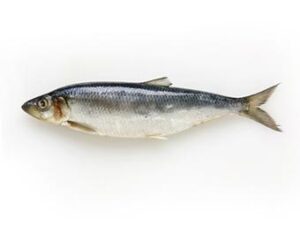
NISHIN (Herring)
Nishin is not often served as nigiri, which is surprising, as it is delicious. It first begins to appear at fish markets in January and February in Japan, and peaks in quality in the spring time. Not quite similar to sanma, iwashi, or kohada, nishin has a flavor all its own, with good fat content and a strong yet refined aroma.
